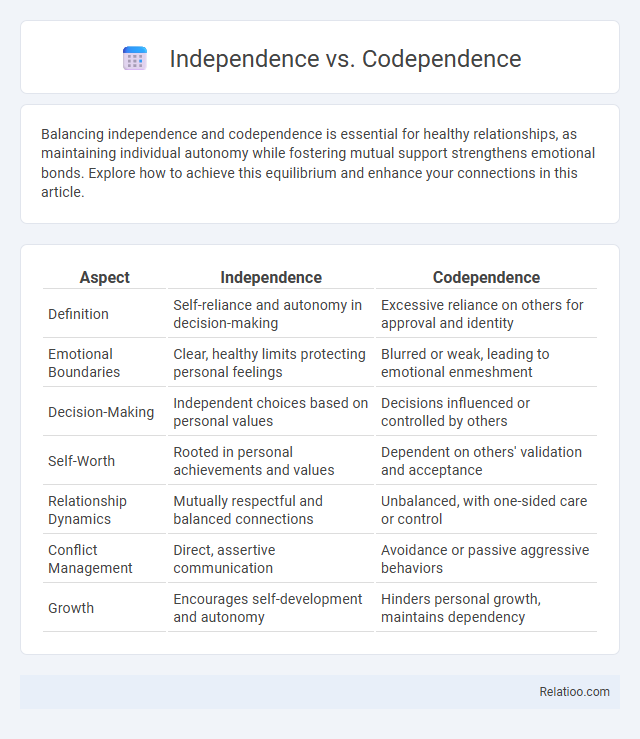Balancing independence and codependence is essential for healthy relationships, as maintaining individual autonomy while fostering mutual support strengthens emotional bonds. Explore how to achieve this equilibrium and enhance your connections in this article.
Table of Comparison
| Aspect | Independence | Codependence |
|---|---|---|
| Definition | Self-reliance and autonomy in decision-making | Excessive reliance on others for approval and identity |
| Emotional Boundaries | Clear, healthy limits protecting personal feelings | Blurred or weak, leading to emotional enmeshment |
| Decision-Making | Independent choices based on personal values | Decisions influenced or controlled by others |
| Self-Worth | Rooted in personal achievements and values | Dependent on others' validation and acceptance |
| Relationship Dynamics | Mutually respectful and balanced connections | Unbalanced, with one-sided care or control |
| Conflict Management | Direct, assertive communication | Avoidance or passive aggressive behaviors |
| Growth | Encourages self-development and autonomy | Hinders personal growth, maintains dependency |
Understanding Independence and Codependence
Understanding independence involves recognizing your ability to make decisions, take responsibility, and maintain personal boundaries without relying excessively on others. Codependence occurs when your emotional well-being depends heavily on another person, often leading to unhealthy relationships and loss of self-identity. Developing true independence requires balancing self-reliance with healthy interdependence, fostering confidence and emotional resilience.
Core Traits of Independent Individuals
Independent individuals exhibit self-reliance, strong decision-making skills, and emotional resilience, enabling them to manage challenges without excessive reliance on others. They possess a high level of self-awareness and confidence, setting personal boundaries and pursuing goals autonomously. Core traits also include accountability for their actions and a proactive approach to problem-solving, distinguishing true independence from codependence or mere dependence.
Defining Codependence: Key Characteristics
Codependence is characterized by an excessive emotional or psychological reliance on a partner, often leading to a loss of personal identity and boundaries. Key traits include a strong need for approval, difficulty asserting oneself, and a pattern of enabling another's dysfunctional behavior. This contrasts with healthy independence, where individuals maintain their own sense of self while engaging in balanced interdependence.
Psychological Roots of Independence
The psychological roots of independence originate from early childhood experiences that foster autonomy, self-efficacy, and secure attachment styles, enabling individuals to develop confidence in their decision-making and problem-solving abilities. Independence thrives when caregivers provide consistent support while encouraging exploration, promoting a healthy balance between self-reliance and social connection. In contrast, codependence often stems from dysfunctional relational patterns where personal boundaries are blurred, leading to excessive emotional reliance on others and undermining personal growth.
The Origins of Codependent Behavior
Codependent behavior often originates from early family dynamics where emotional needs were unmet or where roles blurred between caregiver and dependent, leading to an imbalance in healthy boundaries. Your patterns of codependence may stem from experiences of neglect, control, or trauma that shape how you relate to others and yourself. Understanding these origins is crucial in shifting towards independence by fostering self-awareness and emotional autonomy.
Impacts on Relationships: Independence vs Codependence
Independence fosters healthy relationships by encouraging personal growth, self-reliance, and mutual respect, allowing both partners to maintain their identities while supporting each other's goals. Codependence often leads to imbalance, where one partner sacrifices their needs for the other's approval, causing emotional strain and reduced self-esteem. Understanding the impacts of these dynamics empowers you to build stronger, more balanced relationships rooted in trust and autonomy.
Signs You May Be Too Independent or Codependent
Recognizing signs of being too independent includes reluctance to ask for help, difficulty trusting others, and feeling burdened by handling everything alone. Conversely, codependent behaviors involve excessive people-pleasing, fear of rejection, and neglecting Your own needs to prioritize others. Balancing independence and codependence requires awareness of these patterns to foster healthy relationships and personal growth.
Benefits and Limitations of Independence
Independence offers you greater self-reliance, decision-making authority, and personal growth opportunities, fostering confidence and autonomy. However, it may also lead to isolation and increased responsibility stress without the collaborative support found in codependence or interdependence. Balancing the benefits of independence with its limitations allows for healthier relationships and enhanced emotional resilience.
Risks and Consequences of Codependence
Codependence often leads to diminished personal boundaries and emotional burnout, increasing the risk of mental health issues such as anxiety and depression. Relationships marked by codependence can foster unhealthy dynamics, including enabling destructive behaviors and stifling individual growth. Over time, these patterns may result in chronic dissatisfaction and impaired decision-making, hindering overall well-being and autonomy.
Strategies for Achieving Healthy Interdependence
Achieving healthy interdependence involves balancing personal autonomy with mutual support, fostering open communication, and setting clear boundaries to respect individual needs. Prioritizing empathy and collaborative decision-making enhances relational trust while maintaining self-identity. Implementing consistent self-reflection and emotional regulation strategies promotes growth and resilience within interconnected relationships.

Infographic: Independence vs Codependence
 relatioo.com
relatioo.com